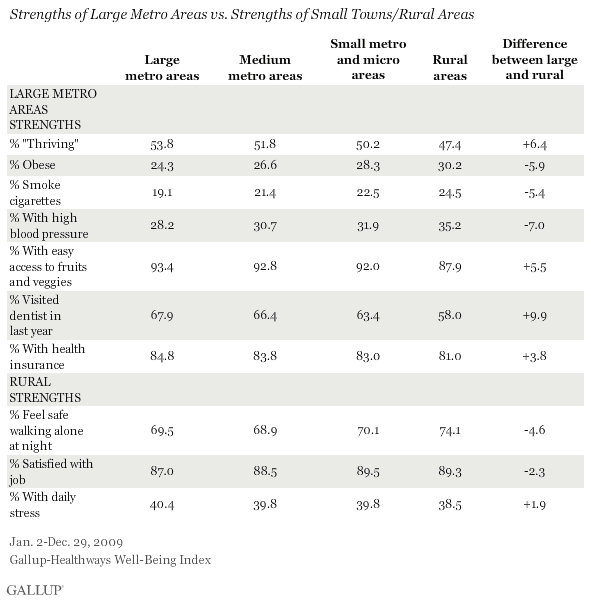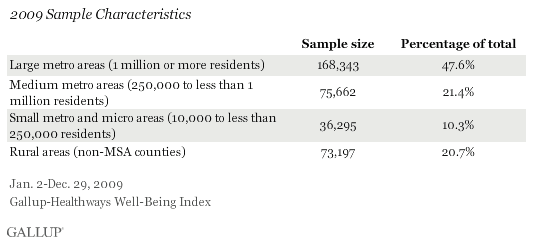Editor's Note: This story has been updated to reflect Gallup's re-estimate of its Gallup-Healthways Well-Being Index and Life Evaluation Index data from January 2008 to April 2009. .
WASHINGTON, D.C. -- Adult residents living in large metropolitan areas enjoy better well-being than do residents living in small towns and rural areas according to the Gallup-Healthways Well-Being Index. Across six domains of well-being, only in the Work Environment domain do inhabitants living in small towns and rural areas have superior scores to their counterparts living in big metro areas.

The score measures six sub-indexes, which individually examine life evaluation, emotional health, work environment, physical health, healthy behaviors, and access to basic necessities. The overall composite score and each of the six sub-indexes' scores are calculated on a scale from 0 to 100, where 100 represents fully realized well-being. ���۴�ýand Healthways initiated the Well-Being Index in January 2008.
For more information on what each sub-index comprises, see page 2.
The large, medium, small/micropolitan, and rural areas categories are based on the Metropolitan Statistical Areas (MSAs) as defined by the U.S. Office of Management and Budget. Large metro areas have at least 1 million residents; medium metro areas have 250,000 to less than 1 million residents; small metro and micropolitan areas have 10,000 to less than 250,000 residents; and rural areas are non-MSA areas.
Smoking, Obesity, High Blood Pressure All Lower in Large Metro Areas
Residents living in large metro areas enjoy decided advantages over residents living in small towns and rural areas on several individual well-being metrics, including obesity, smoking habits, regular use of a dentist, and having health insurance. While folks living in small towns and rural areas feel safer walking alone at night and have lower daily stress, people living in big metro areas have lower rates of diabetes, high cholesterol, cancer, and health issues that prevent normal activities. Job satisfaction, however, is somewhat higher in small towns and rural areas.

Bottom Line
Leaders of large metro areas should take notice that well-being is not only as attainable in big cities as it is in small towns; it is in fact higher on average. With this realization comes greater urgency for low-performing cities to address head-on deficiencies in well-being among the citizenry of their municipalities. Residents living in small towns and rural areas, in turn, should recognize that quieter, calmer settings do not necessarily translate to better well-being, and they should make more aggressive efforts to overcome lower overall performance.
Learn more about the .
Survey Methods
Results are based on telephone interviews with more than 353,000 American adults, aged 18 and older, conducted Jan. 2- Dec. 29, 2009.
The large, medium, small/micropolitan, and rural areas categories are based on the Metropolitan Statistical Areas (MSAs) as defined by the U.S. Office of Management and Budget. Each respondent is attributed to his or her MSA based on the self-report of his or her ZIP Code. In many cases, more than one city is included in the same MSA. The San Jose, Calif., metropolitan statistical area, for example, also includes the smaller nearby cities of Sunnyvale and Santa Clara in addition to San Jose itself, but residents of all three cities would be considered a part of a "large metro area" because the combined population is estimated at more than 1.8 million.
See which cities are included in each category.
For the four groups of respondents in this article, one can say with 95% confidence that the maximum margin of sampling error is no more than ±0.5 percentage points.

Interviews are conducted with respondents on landline telephones (for respondents with a landline telephone) and cellular phones (for respondents who are cell phone only and cell phone mostly).
In addition to sampling error, question wording and practical difficulties in conducting surveys can introduce error or bias into the findings of public opinion polls.
About the Gallup-Healthways Well-Being Index™
The Gallup-Healthways Well-Being Index measures the daily pulse of U.S. well-being and provides best-in-class solutions for a healthier world. To learn more, please visit .
